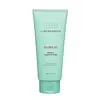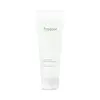What's inside
What's inside
 Key Ingredients
Key Ingredients

 Benefits
Benefits

 Concerns
Concerns

 Ingredients Side-by-side
Ingredients Side-by-side

Water
Skin ConditioningMyristic Acid
CleansingGlycerin
HumectantMethylpropanediol
SolventPotassium Hydroxide
BufferingCoco-Glucoside
CleansingLauric Acid
CleansingPalmitic Acid
EmollientStearic Acid
CleansingMelaleuca Alternifolia Leaf Extract
PerfumingSalicylic Acid
MaskingGlyceryl Stearate
EmollientMelaleuca Alternifolia Flower/Leaf/Stem Extract
Skin ConditioningMelaleuca Alternifolia Leaf Water
AntimicrobialMelaleuca Alternifolia Leaf Oil
AntioxidantCentella Asiatica Extract
CleansingSorbitan Olivate
EmulsifyingPanthenol
Skin ConditioningBeta-Glucan
Skin ConditioningSodium Phytate
1,2-Hexanediol
Skin ConditioningWater, Myristic Acid, Glycerin, Methylpropanediol, Potassium Hydroxide, Coco-Glucoside, Lauric Acid, Palmitic Acid, Stearic Acid, Melaleuca Alternifolia Leaf Extract, Salicylic Acid, Glyceryl Stearate, Melaleuca Alternifolia Flower/Leaf/Stem Extract, Melaleuca Alternifolia Leaf Water, Melaleuca Alternifolia Leaf Oil, Centella Asiatica Extract, Sorbitan Olivate, Panthenol, Beta-Glucan, Sodium Phytate, 1,2-Hexanediol
Water
Skin ConditioningGlycerin
HumectantSodium Cocoyl Isethionate
CleansingPotassium Cocoyl Glycinate
Lauryl Hydroxysultaine
CleansingSodium Chloride
MaskingCitric Acid
BufferingGlyceryl Oleate
EmollientC10-16 Alkyl Glucoside
EmulsifyingCaprylyl/Capryl Glucoside
CleansingStearic Acid
CleansingGlycol Distearate
EmollientHydroxypropyl Starch Phosphate
Salicylic Acid
MaskingSorbitan Olivate
EmulsifyingHouttuynia Cordata Extract
Skin Conditioning1,2-Hexanediol
Skin ConditioningSodium Benzoate
MaskingDisodium EDTA
Allantoin
Skin ConditioningHydroxyethylcellulose
Emulsion StabilisingEthylhexylglycerin
Skin ConditioningAloe Barbadensis Leaf Extract
EmollientOlea Europaea Fruit Oil
MaskingBrassica Oleracea Italica Extract
AstringentMedicago Sativa Extract
TonicBrassica Oleracea Capitata Leaf Extract
Skin ConditioningTriticum Vulgare Germ Extract
Skin ConditioningBrassica Campestris Extract
Skin ConditioningRaphanus Sativus Seed Extract
Skin ConditioningMelaleuca Alternifolia Leaf Extract
PerfumingCamellia Sinensis Leaf Extract
AntimicrobialGalactomyces Ferment Filtrate
HumectantCentella Asiatica Extract
CleansingCarica Papaya Fruit Extract
Skin ConditioningMelaleuca Alternifolia Leaf Oil
AntioxidantTocopheryl Acetate
AntioxidantSodium Hyaluronate
HumectantCaprylyl Glycol
EmollientPanthenol
Skin ConditioningGlycyrrhiza Uralensis Root Extract
Skin ConditioningDiospyros Kaki Leaf Extract
Skin ProtectingMorus Alba Bark Extract
Skin ConditioningOpuntia Coccinellifera Fruit Extract
Skin ConditioningButylene Glycol
HumectantMadecassoside
AntioxidantDextrin
AbsorbentAsiaticoside
AntioxidantWater, Glycerin, Sodium Cocoyl Isethionate, Potassium Cocoyl Glycinate, Lauryl Hydroxysultaine, Sodium Chloride, Citric Acid, Glyceryl Oleate, C10-16 Alkyl Glucoside, Caprylyl/Capryl Glucoside, Stearic Acid, Glycol Distearate, Hydroxypropyl Starch Phosphate, Salicylic Acid, Sorbitan Olivate, Houttuynia Cordata Extract, 1,2-Hexanediol, Sodium Benzoate, Disodium EDTA, Allantoin, Hydroxyethylcellulose, Ethylhexylglycerin, Aloe Barbadensis Leaf Extract, Olea Europaea Fruit Oil, Brassica Oleracea Italica Extract, Medicago Sativa Extract, Brassica Oleracea Capitata Leaf Extract, Triticum Vulgare Germ Extract, Brassica Campestris Extract, Raphanus Sativus Seed Extract, Melaleuca Alternifolia Leaf Extract, Camellia Sinensis Leaf Extract, Galactomyces Ferment Filtrate, Centella Asiatica Extract, Carica Papaya Fruit Extract, Melaleuca Alternifolia Leaf Oil, Tocopheryl Acetate, Sodium Hyaluronate, Caprylyl Glycol, Panthenol, Glycyrrhiza Uralensis Root Extract, Diospyros Kaki Leaf Extract, Morus Alba Bark Extract, Opuntia Coccinellifera Fruit Extract, Butylene Glycol, Madecassoside, Dextrin, Asiaticoside
Ingredients Explained
These ingredients are found in both products.
Ingredients higher up in an ingredient list are typically present in a larger amount.
1,2-Hexanediol is a synthetic liquid and another multi-functional powerhouse.
It is a:
- Humectant, drawing moisture into the skin
- Emollient, helping to soften skin
- Solvent, dispersing and stabilizing formulas
- Preservative booster, enhancing the antimicrobial activity of other preservatives
Centella Asiatica Extract (Centella) is derived from an herb native to Southeast Asia. It is famous for its anti-inflammatory and soothing properties.
Centella is rich in antioxidants and amino acids, such as Madecassic Acid and Asiaticoside.
Studies show the compounds in centella help with:
The combination of all these properties makes centella effective at soothing, hydrating, and protecting the skin.
Other great components of centella include Vitamin A, vitamin C, several B vitamins, and Asiatic Acid.
Fun fact: Centella has been used as a medicine and in food for many centuries. As a medicine, it is used to treat burns, scratches, and wounds.
Learn more about Centella Asiatica ExtractGlycerin is already naturally found in your skin. It helps moisturize and protect your skin.
A study from 2016 found glycerin to be more effective as a humectant than AHAs and hyaluronic acid.
As a humectant, it helps the skin stay hydrated by pulling moisture to your skin. The low molecular weight of glycerin allows it to pull moisture into the deeper layers of your skin.
Hydrated skin improves your skin barrier; Your skin barrier helps protect against irritants and bacteria.
Glycerin has also been found to have antimicrobial and antiviral properties. Due to these properties, glycerin is often used in wound and burn treatments.
In cosmetics, glycerin is usually derived from plants such as soybean or palm. However, it can also be sourced from animals, such as tallow or animal fat.
This ingredient is organic, colorless, odorless, and non-toxic.
Glycerin is the name for this ingredient in American English. British English uses Glycerol/Glycerine.
Learn more about GlycerinMelaleuca Alternifolia Leaf Extract comes from the Tea Tree, Melaleuca alternifolia, Myrtaceae. This tea tree is native to Australia.
Tea Leaf extract contains antimicrobial and anti-acne properties.
This ingredient has perfuming properties and contains linalool and limonene. These fragrance and terpinen components can cause skin sensitivity.
Learn more about the benefits of Tea Tree Oil here.
Learn more about Melaleuca Alternifolia Leaf ExtractThis tea tree oil comes from the leaves of the Tea Tree plant. Tea tree oil has antioxidant, anti-inflammatory, and antimicrobial properties.
According to the book Journal of Profiles of Drug Substances, tea tree helps in reducing acne-causing bacteria such as Propionibacterium acnes. This is due to the Terpinen components of tea tree oil.
Tea tree may cause sensitivity and irritation for some people. This oil naturally contains fragrance such as linalool and limonene.
However, research shows irritation usually occurs when using pure tea tree oil and not in cosmetic products.
Tea tree oil was found to help relieve the symptoms of psoriasis in one study.
Tea tree oil is toxic when ingested. Another study showed it to caused damage to the nervous system of dogs and cats when applied to their skin or given orally.
Learn more about Melaleuca Alternifolia Leaf OilPanthenol is a common ingredient that helps hydrate and soothe the skin. It is found naturally in our skin and hair.
There are two forms of panthenol: D and L.
D-panthenol is also known as dexpanthenol. Most cosmetics use dexpanthenol or a mixture of D and L-panthenol.
Panthenol is famous due to its ability to go deeper into the skin's layers. Using this ingredient has numerous pros (and no cons):
Like hyaluronic acid, panthenol is a humectant. Humectants are able to bind and hold large amounts of water to keep skin hydrated.
This ingredient works well for wound healing. It works by increasing tissue in the wound and helps close open wounds.
Once oxidized, panthenol converts to pantothenic acid. Panthothenic acid is found in all living cells.
This ingredient is also referred to as pro-vitamin B5.
Learn more about PanthenolSalicylic Acid (also known as beta hydroxy acid or BHA) is a well-known ingredient for treating skin that struggles with acne and clogged pores. It exfoliates both the skin's surface and deep within the pores to help clear out buildup, control oil, and reduce inflammation.
Unlike AHAs (alpha hydroxy acids), salicylic acid is oil-soluble. This allows it to penetrate into pores which makes it especially effective for treating blackheads and preventing future breakouts.
Salicylic acid is also known for its soothing properties. It has a similar structure to aspirin and can calm inflamed or irritated skin, making it a good option for acne-prone skin that is also sensitive.
Concentrations of 0.5-2% are recognized by the U.S. FDA as an over-the-counter topical acne product.
It can cause irritation and/or dryness if one's skin already has a compromised moisture barrier, so it's best to focus on repairing that before introducing this ingredient into your routine.
While salicylic acid does not increase sun sensitivity, it’s still important to wear sunscreen daily to protect your skin.
If you are looking for the ingredient called BHA or Butylated Hydroxyanisole, click here.
Learn more about Salicylic AcidSorbitan Olivate is created from the fatty acids in olive oil and sorbitol.
This ingredient is an oil in water emulsifier. It helps stabilize a product by preventing oils and waters from separating. Sorbitan Olivate also helps hydrate the skin.
Manufacturers sell sorbitan olivate under the name OliveM 1000. OliveM 1000 a multifunctional ingredient. It is self-emulsifying. According to a manufacturer, OliveM 1000 does not disrupt natural skin biome.
Due to its olive oil base, this ingredient may not be fungal-acne safe.
Learn more about Sorbitan OlivateStearic Acid is a fatty acid. It is an emollient, emulsifier, and texture enhancer.
As an emollient, stearic acid helps soften skin. It aids the skin's protective barrier by preventing water loss. It also provides a gentle cleansing effect without stripping away natural oils.
Stearic acid may also be used to enhance the texture of products. It can add volume and stabilize ingredients such as water and oil. This can help water and oil ingredients from separating.
Sources of stearic acid include animal or vegetable fats/oils such as coconut or shea. It can be naturally found in butter, cocoa butter, shea butter, vegetable fats, and animal tallow.
This ingredient may not be Malassezia folliculitis, or fungal-acne safe.
Learn more about Stearic AcidWater. It's the most common cosmetic ingredient of all. You'll usually see it at the top of ingredient lists, meaning that it makes up the largest part of the product.
So why is it so popular? Water most often acts as a solvent - this means that it helps dissolve other ingredients into the formulation.
You'll also recognize water as that liquid we all need to stay alive. If you see this, drink a glass of water. Stay hydrated!
Learn more about Water